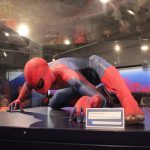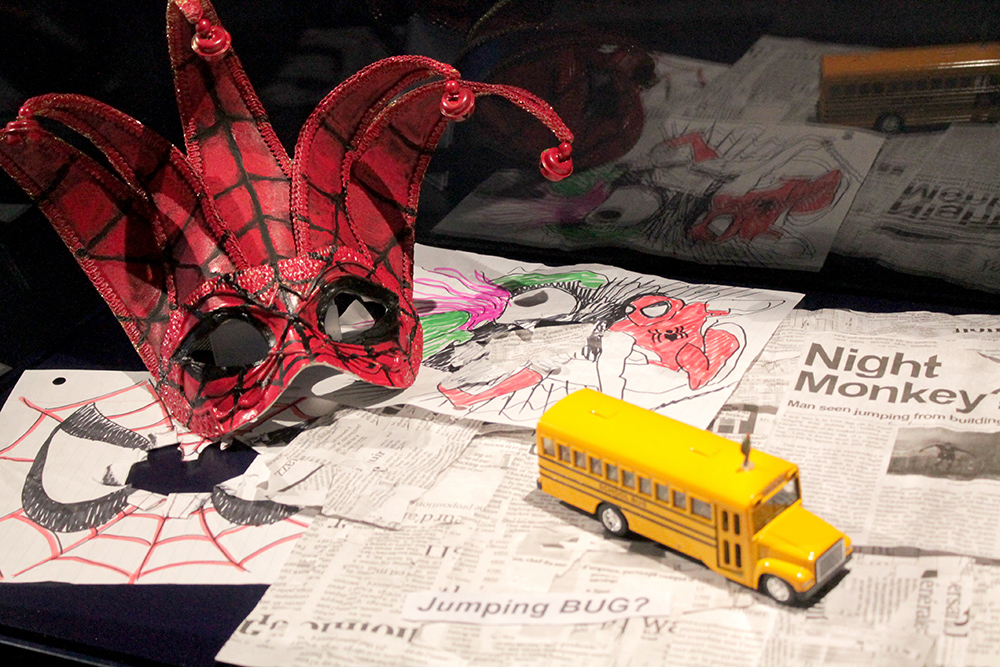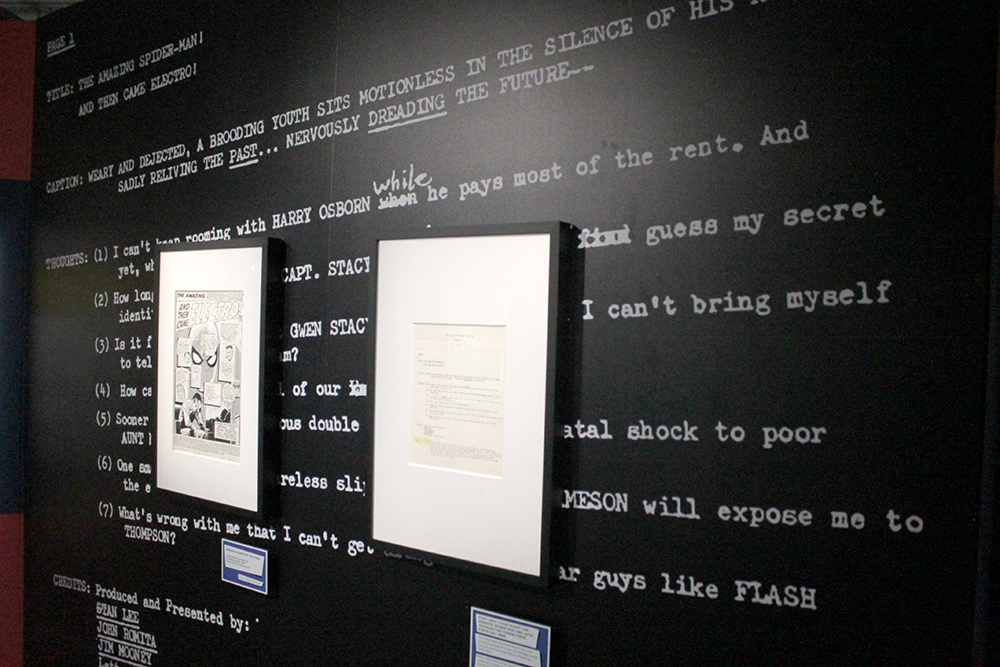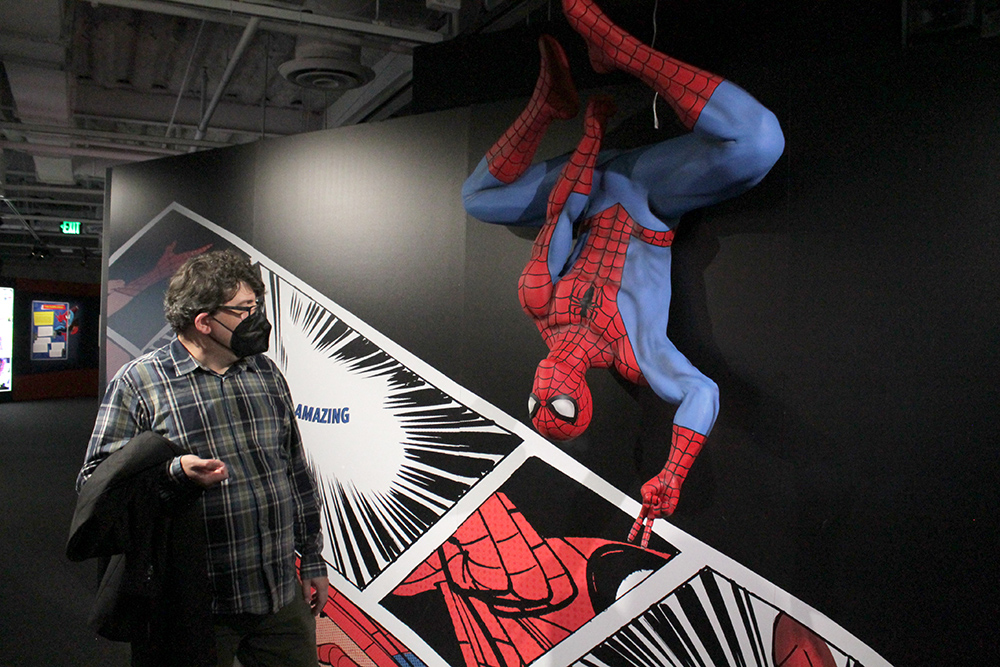Spider-Man exhibit explores cultural impact of web-slinger

By KENDRA SITTON
Celebrating the masked hero’s 60th anniversary, the Comic-Con Museum is open for the public to view the world’s first-ever Spider-Man exclusive exhibit, “Spider-Man: Beyond Amazing – The Exhibition” until Jan. 3, 2023.
In a recent visit from New York City, co-curator and Patrick A. Reed provided tours of the exhibit he and Ben Saunders put together ahead of this summer’s convention.
While the pop culture historians behind the exhibit ensured that the legacy of Peter Parker was central, they also demonstrated that Spider-Man is more than just Peter Parker and the Spider-verse now spans into an entire Spider-verse of related characters. In addition, Spider-Man is no longer confined to the panels of a comic book and is now a multi-media icon in nearly all forms of storytelling media.

“Everybody comes to Spider-Man from a different direction,” Reed said.
The Comic-Con Museum has to cater to dedicated fans who care about the minutiae of Spider-Man’s history as well as young kids who think Spider-Man wears a cool costume and does cool stuff like climb walls. Between movie props, multi-media installations, life-size sculptures and a plethora of original art lining the walls, Reed hopes there is something for everyone in the exhibit.
With an original score for the exhibit on loop, moving lights and digital screens throughout the exhibit, a visit that could just be a chance to look at flat art on the walls becomes an immersive experience. Still, Reed and Saunders included detailed explanations and unique artifacts that keep the exhibit from just being a multi-media experience like the Marvel characters featured in Disneyland’s Innoventions before its closure in 2015.
Disney’s influence is still apparent with the atrium before the exhibit is filled with 3D sculptures, projections on three walls, and giant printed comic panels that draw an attendee into the story, or in other words, the pre-ride. Then, attendees weave through the halls that make up the exhibit itself before landing in a gift shop crowded with Spider-verse merchandise (very similar to how rides at DisneyLand end).

Once the meat of the exhibit begins, Reed and Saunders tell three simultaneous stories from the beginning. The curators tell the fictional story of Peter Parker’s origin alongside the real history of co-creators Stan Lee and Steve Ditko as well as later contributors. In addition, the evolving art of Spider-Man is prominent, first in archival sketches of comic book panels all the way up to props from the most recent film installation “Spider-Man: No Way Home.”
The exhibit chronicles the first appearance of Spider-Man in a 1962 comic book in a series that was already canceled. When the comic was a runaway hit, the red-and-blue costumed hero got his own series. It was important to Reed and Saunders not just to showcase a detailed history of the character but to demonstrate the impact the character had on pop culture.
Spider-Man debuted as teenagers were becoming a distinct segment of American society with spending money of their own that gave them influence. As media companies tried to cater to this new audience, teens resonated with a teenage hero who made mistakes and worried just as much about the girl he had a crush on as a villainous plot to take over NYC.

“It’s the early 1960s. So the concept of the teenager, as an entity, is still fairly fresh in American culture. And there’s a whole subsection of media that’s being devoted to appealing to teenagers. American culture is recognizing that this is a very potentially profitable demographic and at the same time, there’s a lot of templates that have yet to be fully explored,” Reed said, “Spider-Man… sets up a story of Peter Parker who is a not entirely popular teenager. He is misunderstood; he is shunned by his peers. He gains these powers and does not immediately use them altruistically.”
His costume also gave him unique appeal. Most previous comic heroes had partial masks obscuring their faces or in the case of Superman, no mask at all except as Clark Kent. Instead, Spider-Man is completely covered, giving anyone the ability to imagine he might be someone like them. As the Spider-Verse expanded with Spider-Woman, Miles Morales, and even Spider Ham, that is truer now than ever.

With limited space in the museum, the curators had to choose carefully what to leave out of the exhibit but in examining the cultural impact of Spider-Man, highlighted progressive and inclusive moves made by the creators as the universe expanded from just Spider-Man to include Spider-Woman in the ‘70s and ‘80s.
One artifact demonstrating this is an original sketch from Willi Smith of Mary Jane Watson’s wedding dress. He was commissioned to design the dress in real life, which was worn at a live ceremony officiated by Stan Lee at Shea Stadium and broadcast nationally before a baseball game upon the release of Amazing Spider-Man Annual #21. In the comic itself, a fictional Smith gifts the wedding dress to Mary Jane ahead of her wedding to Spider-Man.

“Willi Smith was a queer African American club kid from New York City. And he became a designer whose entire ethos was democratizing high fashion and making it accessible. He launched the first line of streetwear and high fashion that was available at a reasonable price point in mainstream outlets,” Reed said.
Smith, a lifetime comic book fan, sadly died of AIDS in 11987 before the comic was released yet his fictional and real legacy is preserved through his part in the wedding.
Studio TK created the digital displays peppered throughout the exhibit that make the installation come alive visually. One such display at the end of the exhibit is a long wall of with a spider web embedded with small screens flipping through images of the many permutations of Spider-verse characters. Marvel even sent the studio images of characters who had yet to be debuted or announced when the exhibit opened.

“It’s not only the past and present of the Spider-Verse. It also has some little hints toward the future,” Reed said.
The images even include little-known characters like Val, the first-ever Spider-Woman who appeared only once in a PBS special. As a Black woman with an afro in the 1970s, she is an example of the Spider-Verse being for everyone.
“[The web] is a really nice way to sort of bring home the vast potential and the expansiveness of the Spider-Verse and the sort of universality of the concept of Spider-Man at this point, and how pretty much everyone can be a Spider-Man,” Reed said.


The post Spider-Man exhibit explores cultural impact of web-slinger appeared first on SDNews.com.
Categories
Recent Posts










GET MORE INFORMATION


